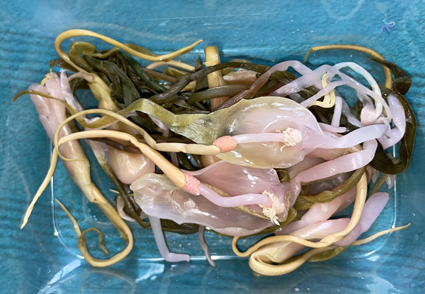Abstract
Recent fieldwork in Monywa District, Sagaing Region, Myanmar resulted in the discovery of a species new to science, Typhonium edule, which is herein described and illustrated. It superficially resembles T. lineare but differs in having wider spathe diameter, spathe limb 3–4 times longer than the tube, downwardly curved sickled-shaped staminodes and strongly stipitate appendix. Detailed description, colour plates, distribution map, phenology and ecology of this new Typhonium species are provided below.
References
<p>Beentje, H. (2016) <em>The Kew plant glossary: an illustrated dictionary of plant terms. 2nd ed. </em>Royal Botanic Garden, Kew, 184 pp.</p>
<p>Gage, A.T. (1903) The vegetation of the district of Minbu in upper Burma. <em>Records of the Botanical Survey of India </em>3: 1–376.</p>
<p>Hetterscheid, W.L.A. & Nguyen, V.D. (2001) Three new species of <em>Typhonium</em> (Araceae) from Vietnam. <em>Aroideana </em>24: 24–29.</p>
<p>Hetterscheid, W.L.A, Sookchaloem, D. & Murata, J. (2001) <em>Typhonium</em> (Araceae) of Thailand: New species and a revised Key. <em>Aroideana</em> 24: 33–55.</p>
<p>Hetterscheid, W.L.A. & Sookchaloem, D. (2012) <em>Typhonium</em>–Araceae.<em> In: </em>Santisuk, T. & Larsen, K. (Eds.) <em>Flora of Thailand, vol.</em> 11 (2). Forest Herbarium, Royal Forest Department, Bangkok, pp. 298–321.</p>
<p>IUCN Standards and Petitions Subcommittee. (2019) Guidelines for Using the IUCN Red List Categories and Criteria. Version 14. Available from: http://www.iucnredlist.org/documents/RedListGuidelines.pdf (accessed 5 March 2021)</p>
<p>King, G. & Prain, D. (1898) Description of some new plants from the North-Eastern Frontiers of India. <em>Journal of the Asiatic Society of Bengal. Part. 2. Natural History</em> 67: 284–305.</p>
<p>Kress, W.J., Filipps, D., Farr, R.A. & Kyi, D.Y.Y. (2003) A checklist of the trees, shrubs, herbs, and climbers of Myanmar. <em>Contributions from the United States National Herbarium </em>45: 1–590.</p>
<p>Mayo, S.J., Bogner, J. & Boyce, P.C. (1997) The genera of Araceae. Royal Botanic Gardens, Kew, Richmond, pp. 260–263.</p>
<p>Murata, J., Sookchaloem, D. & Hetterscheid, W.L.A. (2002) <em>Typhonium watanabei</em> (Araceae), a new species from Thailand. Journal of Japanese Botany 77: 163–166.</p>
<p>Murata, J., Ohi-Toma, T. & Tanaka, N. (2010) New or Noteworthy Plant Collections from Myanmar (4): <em>Typhonium cordifolium </em>and two new species, <em>T. neogracile </em>and <em>T. praecox</em> (Araceae). <em>Journal of Japanese Botany</em> 85: 1–7.</p>
<p>Naive, M.A.K., Hein, K.Z., Ma, Z.X. & Du, N.V. (2020) Taxonomic studies of Araceae in Myanmar I: <em>Typhonium sagaingense</em>, a new Areae species from Sagaing Region. <em>Phytotaxa</em> 471: 47–53. https://doi.org/10.11646/phytotaxa.471.1.5</p>
<p>Schott, H.W. (1829) Für Liebhaber der Botanik. <em>Wiener Zeitschriftfür Kunst, Litteratur, Theater und Mode</em> 3: 732.</p>
<p>Sriboonma, D., Murata, J. & Iwatsuki, K. (1994) A revision of <em>Typhonium</em> (Araceae). <em>Journal of the Faculty of Science, University of Tokyo, Section 3 Botany</em> 15: 255–313.</p>
<p>Gage, A.T. (1903) The vegetation of the district of Minbu in upper Burma. <em>Records of the Botanical Survey of India </em>3: 1–376.</p>
<p>Hetterscheid, W.L.A. & Nguyen, V.D. (2001) Three new species of <em>Typhonium</em> (Araceae) from Vietnam. <em>Aroideana </em>24: 24–29.</p>
<p>Hetterscheid, W.L.A, Sookchaloem, D. & Murata, J. (2001) <em>Typhonium</em> (Araceae) of Thailand: New species and a revised Key. <em>Aroideana</em> 24: 33–55.</p>
<p>Hetterscheid, W.L.A. & Sookchaloem, D. (2012) <em>Typhonium</em>–Araceae.<em> In: </em>Santisuk, T. & Larsen, K. (Eds.) <em>Flora of Thailand, vol.</em> 11 (2). Forest Herbarium, Royal Forest Department, Bangkok, pp. 298–321.</p>
<p>IUCN Standards and Petitions Subcommittee. (2019) Guidelines for Using the IUCN Red List Categories and Criteria. Version 14. Available from: http://www.iucnredlist.org/documents/RedListGuidelines.pdf (accessed 5 March 2021)</p>
<p>King, G. & Prain, D. (1898) Description of some new plants from the North-Eastern Frontiers of India. <em>Journal of the Asiatic Society of Bengal. Part. 2. Natural History</em> 67: 284–305.</p>
<p>Kress, W.J., Filipps, D., Farr, R.A. & Kyi, D.Y.Y. (2003) A checklist of the trees, shrubs, herbs, and climbers of Myanmar. <em>Contributions from the United States National Herbarium </em>45: 1–590.</p>
<p>Mayo, S.J., Bogner, J. & Boyce, P.C. (1997) The genera of Araceae. Royal Botanic Gardens, Kew, Richmond, pp. 260–263.</p>
<p>Murata, J., Sookchaloem, D. & Hetterscheid, W.L.A. (2002) <em>Typhonium watanabei</em> (Araceae), a new species from Thailand. Journal of Japanese Botany 77: 163–166.</p>
<p>Murata, J., Ohi-Toma, T. & Tanaka, N. (2010) New or Noteworthy Plant Collections from Myanmar (4): <em>Typhonium cordifolium </em>and two new species, <em>T. neogracile </em>and <em>T. praecox</em> (Araceae). <em>Journal of Japanese Botany</em> 85: 1–7.</p>
<p>Naive, M.A.K., Hein, K.Z., Ma, Z.X. & Du, N.V. (2020) Taxonomic studies of Araceae in Myanmar I: <em>Typhonium sagaingense</em>, a new Areae species from Sagaing Region. <em>Phytotaxa</em> 471: 47–53. https://doi.org/10.11646/phytotaxa.471.1.5</p>
<p>Schott, H.W. (1829) Für Liebhaber der Botanik. <em>Wiener Zeitschriftfür Kunst, Litteratur, Theater und Mode</em> 3: 732.</p>
<p>Sriboonma, D., Murata, J. & Iwatsuki, K. (1994) A revision of <em>Typhonium</em> (Araceae). <em>Journal of the Faculty of Science, University of Tokyo, Section 3 Botany</em> 15: 255–313.</p>


